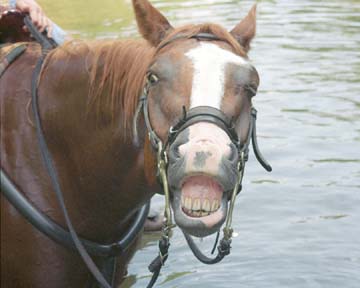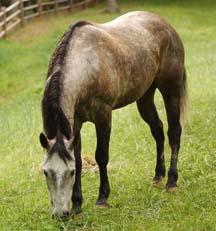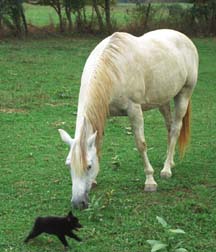
|
|
Not Just for Kids
Horses in Spring
by Nancy Hoffmann • photos by Phil Hoffmann

It’s spring, and the grass just keeps growing and growing. Seems as if you can always hear the roar of a lawn mower in the neighborhood. But there’s one kind of grass cutter who’s very quiet. That’s a horse.
Horses enjoy eating the spring grass after a winter of getting by on hay and grains. Grass is their natural diet. Since they spend nearly 20 hours a day eating and only about three hours sleeping, they eat a lot of it.
A horse in your yard would probably eat all the grass and leave you nothing but dirt and mud. Most horses need three acres of pasture.
 Horses spend so much time eating that they chew about 50,000 times a day. Tonight at dinner, try to count how many times you chew. That will give you an idea of how much more a horse eats than you. Horses spend so much time eating that they chew about 50,000 times a day. Tonight at dinner, try to count how many times you chew. That will give you an idea of how much more a horse eats than you.
Grass may appear soft, almost like lettuce, but horses don’t wash the grass before they eat it. Go into your yard and rip up a few blades. Can you feel the dirt and grit on them? If you had to eat that all day, you’d wear down your teeth.
It’s no problem for horses; their teeth continue to grow or ‘erupt’ for most of their lives. They also have enamel, a hard, protective substance, throughout their teeth. In contrast, it’s only an outer coating on your teeth, like icing on a cake. The extra enamel makes horses’ teeth very strong.
With all the chewing and grinding and the constant erupting, a horse’s teeth eventually become uneven with peaks and valleys and sharp points. So every year, horses have to visit the dentist.
The horse dentist is a veterinarian who comes to the farm. Using a rasp and drill, the vet files down or ‘floats’ the horse’s teeth back into an even, straight line, which makes it easier for the horse to eat.
How Tall is a Horse?
Horses aren’t measured from the tops of their heads like you are. They’re measured from the withers. Withers is the area just above their shoulders where the neck joins the back. Many horses have a slight bulge at the withers, which makes it easy to spot.
Don’t ever state a horse’s height in feet and inches because horses are measured in ‘hands.’ For instance, Misty, the white horse you see to the left, is 15 hands. Look up ‘hand’ in the dictionary to find out how many inches are in a hand. Then multiply that by 15 and that will tell you how tall Misty is at the withers.
 Did You Know? Did You Know?
Unlike dogs, which do not sweat, horses sweat all over their bodies. But sweating makes them very itchy, especially in the spring when they shed their winter coats. So after a long ride when they’ve worked up a good sweat, the first thing horses do when they’re turned back out in the pasture is find a patch of dirt to roll in. It’s how they get a good scratch all over their bodies.
Horses Run Races
Every spring, horses are the athletes to whom everybody pays attention. That’s because three famous horse races run this time of year. Taken together, they’re called the Triple Crown, and if one horse wins them all, he (only three times has it been she) becomes rich and famous.
On the first Saturday in May, three-year-old Thoroughbred horses compete for $1 million in prizes in the Kentucky Derby. A horse named Funny Cide won the 126th derby two weeks ago.
This Saturday the Triple Crown moves to Maryland. You can watch the Preakness Stakes in person at Pimlico race track in Baltimore. Or you can see it at home on television. The race comes on at 5pm, and ‘post time’ is 6pm.
In New York on the first Saturday of June, the Belmont Stakes completes the race for Triple Crown.
This Week's Kids Stuff
Thursday, May 15
Tiny Tot Trot
Young nature lovers, ages 2-3, learn about and discover wild babies with a naturalist. 10am @ Battle Creek Cypress Swamp, Gray’s Rd. off Sixes Rd., Prince Frederick. $3 w/discounts; rsvp: 410/535-5327.
Saturday, May 17
Robin Hood Comes to Life
Kids experience the theater for the first time watching Robin Hood do battle w/the Sheriff of Nottingham. 11:30am doors open; noon lunch; 12:30pm show begins @ Chesapeake Music Hall, Busch’s Frontage Rd., Annapolis. $12; rsvp: 410/626-7515.
Claws and Paws Day
Children see and learn about rescued unwanted pets: ferrets, parrots, iguanas, greyhounds, cats, snakes, hedgehog, turtles and toads. Park Police mounted officer and K-9 officer on hand to answer questions. 1-4pm @ Watkins Nature Center, Watkins Park Dr., Upper Marlboro. $3; rsvp: 301/218-6702 • www.pgparks.com.
 Tuesday, May 20 Tuesday, May 20
Kids ‘N’ Critters
Children ages 3-5 search for and learn about animals and keep a critter log book. 10:30am @ King’s Landing Park, King’s Landing Rd., Huntington. $3 w/discounts; RSVP: 410/535-5327.
|
|